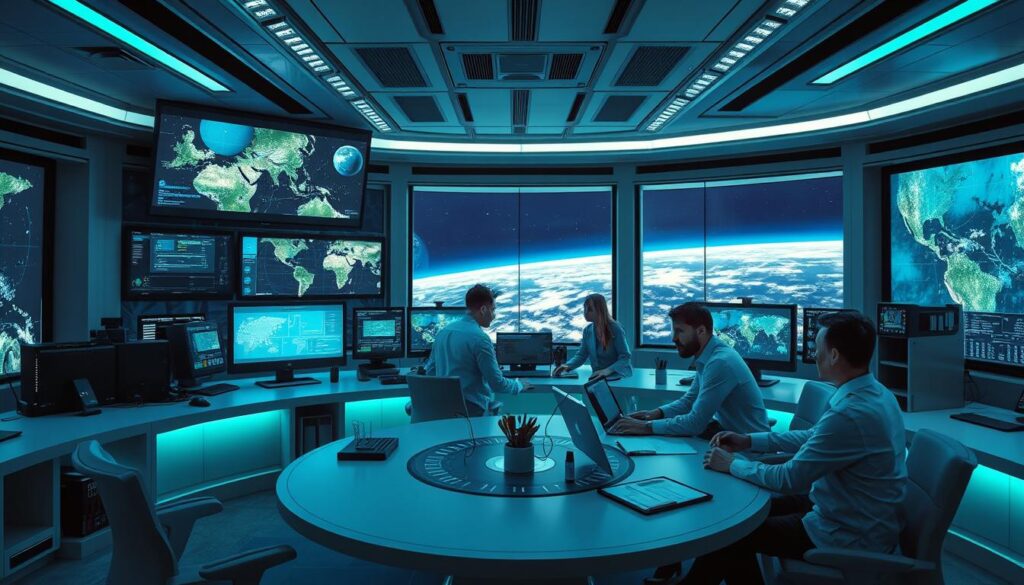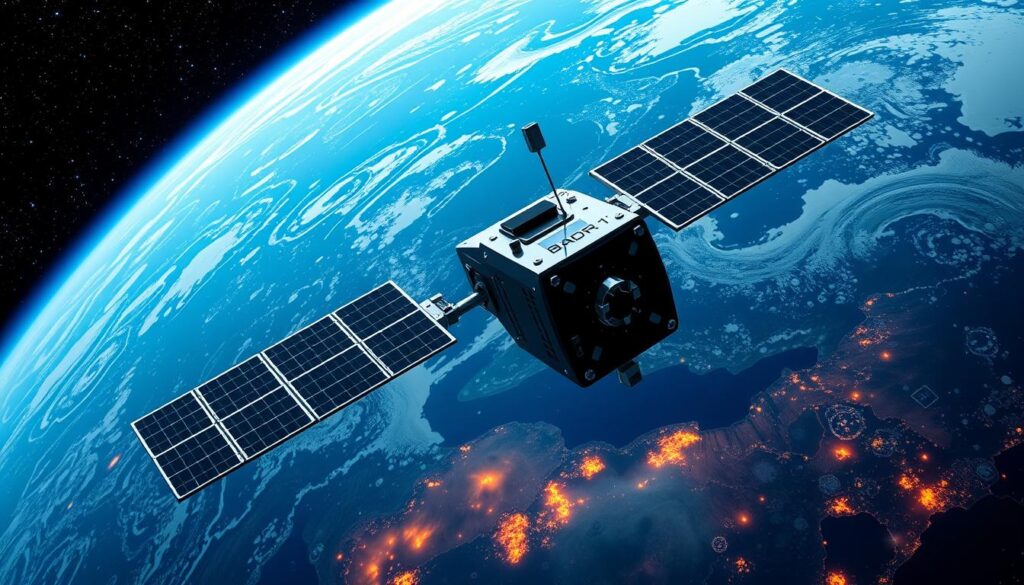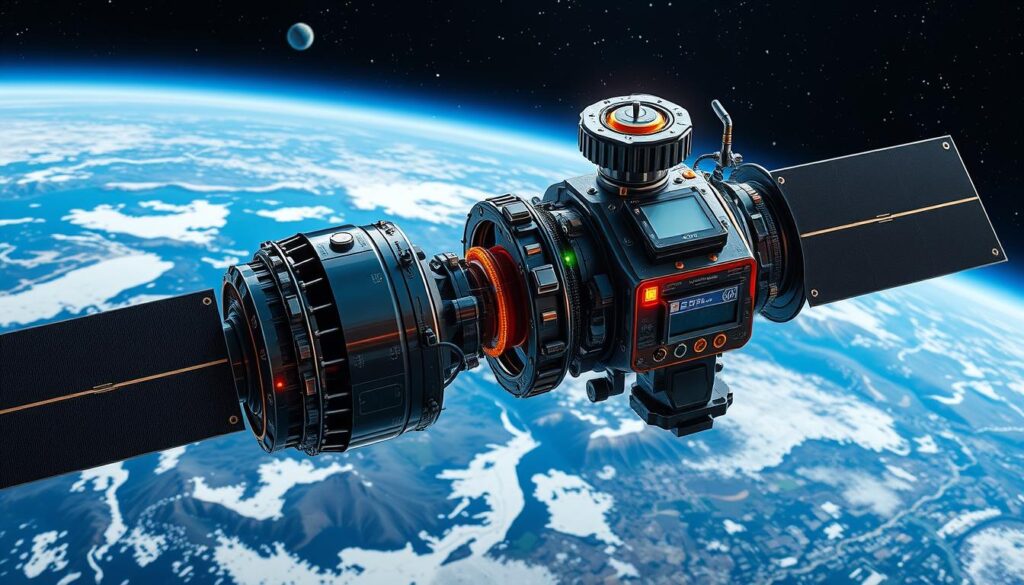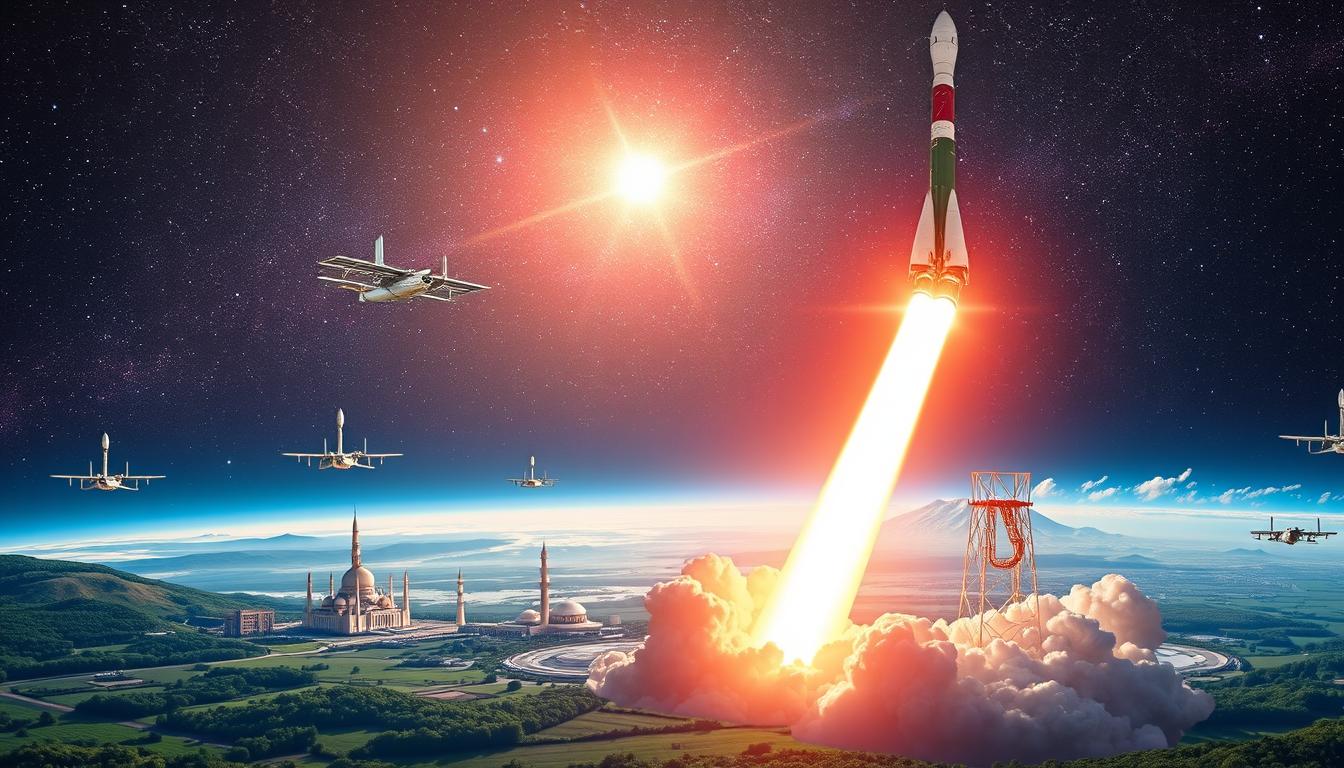Pakistan’s space program has seen both challenges and triumphs. It started in 1961 with SUPARCO, the Space and Upper Atmosphere Research Commission. Despite limited resources and technology hurdles, Pakistan has made big strides. For example, it launched its first satellite, Badr-1, in 1990.
The program has grown, focusing on remote sensing technology. It also sees the strategic value of space. But, it has faced budget issues, building capacity, and geopolitical challenges. This article explores Pakistan’s space program, its successes, and its future goals.
Key Takeaways
- Pakistan’s space program, established in 1961, has faced unique challenges and achieved significant milestones despite limited resources.
- SUPARCO, the country’s space agency, has played a pivotal role in driving Pakistan’s space ambitions.
- The launch of the Badr-1 satellite in 1990 was a landmark achievement in Pakistan’s space exploration efforts.
- The program has expanded its satellite capabilities, focusing on remote sensing technology and exploring the strategic importance of its space endeavors.
- Budgetary constraints, capacity building, and geopolitical considerations have posed obstacles to the program’s progress.
Pakistan’s Nascent Space Endeavors
Pakistan started its space journey in 1961 with the creation of the Space and Upper Atmosphere Research Commission (SUPARCO). This agency was key in starting Pakistan’s space program. It set the stage for the country’s future in space.
Establishment of SUPARCO and Early Milestones
At first, SUPARCO worked on building its base. It launched sounding rockets and did research on the atmosphere. The agency’s first big wins were the Rehbar-I in 1962 and the Shahpar-I in 1967. These successes showed Pakistan’s growing skills in space.
Collaboration with International Space Agencies
Pakistan teamed up with space agencies from the US, China, and France to improve its space tech. These partnerships brought in new tech and knowledge. This global help was key in starting Pakistan’s space journey.

“The successful launch of the Rehbar-I and Shahpar-I sounding rockets marked pivotal moments in Pakistan’s space history, demonstrating the country’s growing proficiency in space technology.”
Thanks to these early partnerships and achievements, SUPARCO became a major player in global space efforts. This set the stage for Pakistan’s future in space.
Badr-1: Pakistan’s First Indigenously Developed Satellite
The launch of Badr-1 in 1990 was a key moment for Pakistan. This 90-kilogram satellite was made by SUPARCO engineers. It was Pakistan’s first satellite made on its own.
Badr-1 aimed to study the Earth’s magnetic field and ionosphere. It was launched by a Chinese rocket and orbited the Earth. This showed Pakistan’s growing space tech skills.
The success of Badr-1 boosted Pakistan’s science and pride. It showed a strong will to grow its space program. This achievement opened doors for more space missions and improved life for Pakistanis.
| Satellite Name | Launch Year | Mass (kg) | Mission |
|---|---|---|---|
| Badr-1 | 1990 | 90 | Gather data on Earth’s magnetic field and ionosphere |

“The launch of Badr-1 marked a significant milestone in Pakistan’s space journey, showcasing our technological advancements and our unwavering commitment to space exploration.”
– Dr. Atta-ur-Rahman, Former Chairman of SUPARCO
Expanding Satellite Capabilities and Remote Sensing Technology
Pakistan’s space program has seen great progress since launching Badr-1, its first homegrown satellite. Now, the focus is on improving remote sensing technology. This has led to the launch of Earth observation satellites. These satellites help Pakistan keep an eye on its natural resources, track environmental changes, and aid in disaster management.
Geostationary Orbit Satellites and Their Applications
The Badr-2, Badr-3, and Paksat-1R satellites are in geostationary orbit. They give Pakistan better coverage and high-resolution images of its land and nearby areas. These remote sensing technology satellites are crucial for many uses, including:
- Agriculture: They help monitor crop growth, spot pests and diseases, and plan resource use.
- Urban Planning: They map urban areas, track land use changes, and support green development.
- Disaster Management: They track natural disasters, assess damage, and help with relief efforts.
- National Security: They boost surveillance and monitoring for border security and strategic planning.
The geostationary orbit satellites have given Pakistan a big edge. They help use satellite-based remote sensing to tackle big challenges and support national goals.
“The successful launch and operation of our Earth observation satellites have been a game-changer for Pakistan, enabling us to harness the power of space-based technologies to address a wide range of pressing issues.”

Pakistan Space program: Challenges and Hurdles
Pakistan’s space program has made great strides, but it faces big challenges. Getting enough money from the government is a big problem. The debate over how to spend resources is ongoing.
Technological issues also slow down progress. These include problems with satellite design and launch systems. Building up scientific and engineering skills is key to overcoming these hurdles.
Budgetary Constraints and Resource Allocation
The space program’s budget is tight. This makes it hard to achieve its goals. The program must compete with other national needs for funds.
This forces tough choices on how to use the limited money. It’s a delicate balance.
Technological Hurdles and Capacity Building
Technological challenges are another hurdle. Designing satellites and setting up launch systems are complex tasks. Building up skills through education and partnerships is essential.
“The success of Pakistan’s space program is not just a matter of national pride, but a strategic necessity in an increasingly competitive global landscape.”
Ariane Rocket Launches and International Collaborations
Pakistan has been working hard to improve its space program. It has teamed up with the European Space Agency (ESA) and its Ariane rocket program. This partnership has helped launch several Pakistani satellites, like Badr-2 and Paksat-1R, into space.
These collaborations have given Pakistan access to top-notch launch technology. They also offer chances for sharing knowledge and working together on research. This way, Pakistan can tackle the challenges of building its own launch systems.
| Satellite | Launch Vehicle | Launch Year |
|---|---|---|
| Badr-2 | Ariane Rocket | 2001 |
| Paksat-1R | Ariane Rocket | 2011 |
The ariane rocket launches and international space collaborations have been key for Pakistan’s space program. They have helped Pakistan grow its satellite and remote sensing technology.
“By leveraging international partnerships, Pakistan has been able to overcome some of the constraints it faces in developing its indigenous launch capabilities.”
Pakistan’s future in space looks bright thanks to its international space collaborations. These partnerships will help Pakistan grow in the global space community. They will also lead to new technologies and research projects.
Aerospace Engineering Advancements and Human Resource Development
Pakistan’s space program focuses on aerospace engineering and a skilled workforce. It has set up academic programs to train the next space scientists and engineers. This is crucial for the country’s future in space.
Academic Programs and Research Initiatives
The Institute of Space Technology and the Karachi Institute of Technology and Entrepreneurship lead in aerospace engineering. They offer degrees and research chances. This helps students in developing the space program, especially in satellite tech and launch systems.
SUPARCO, Pakistan’s space agency, also leads in research. It works with universities to advance space exploration. This creates a space for innovation in aerospace.
- The Institute of Space Technology offers degree programs in aerospace engineering, satellite technology, and space sciences.
- The Karachi Institute of Technology and Entrepreneurship provides training in rocketry, avionics, and satellite design.
- SUPARCO’s research initiatives focus on developing cutting-edge satellite systems, launch vehicles, and remote sensing applications.
Pakistan is growing a new generation of aerospace experts. They will be key in the country’s space program and scientific exploration goals.
“By investing in our human capital and fostering a culture of innovation, we are paving the way for Pakistan to become a regional leader in aerospace technology.”
Future Aspirations: Manned Space Missions and Beyond
Pakistan’s space program is growing, aiming for big goals. One major goal is manned space missions. This means sending Pakistani astronauts to space. The exact timeline is still unknown, but the agency is committed to making it happen.
Pakistan also wants to grow its satellite network and improve Earth observation. They aim to use space for better telecommunications, navigation, and disaster management. These plans show Pakistan’s growing confidence in space exploration.
“The pursuit of manned space missions is a testament to Pakistan’s growing capabilities in the space sector, as the country aims to push the boundaries of its space exploration efforts.”
To achieve these goals, Pakistan faces many challenges. They need to solve technological problems, manage budgets, and find skilled people. But with a focus on innovation and working with other countries, Pakistan is ready to reach new heights.
Pakistan’s space program is full of promise for the future. They aim for manned space missions and to expand their satellite network. These plans will help Pakistan become a major player in the global space community.
Strategic Significance of Pakistan’s Space Program
Pakistan’s space program is important for science and technology. It also impacts national security. The focus is on dual-use technologies, useful for both civilians and the military.
National Security Implications and Dual-Use Technologies
Satellites help with surveillance, reconnaissance, and defense. This makes Pakistan’s space program vital for national security. The program’s growth is linked to its role in defense strategies and global influence.
Pakistan’s space program has led to the creation of dual-use technologies. These include satellite-based remote sensing and communications systems. They boost national security by improving surveillance and defense.
- Satellite-based remote sensing helps monitor borders and natural disasters.
- Communications satellites ensure secure data transmission for military and civilian agencies.
- Navigation systems from space improve the accuracy of defense operations.
The space program’s growth is key to Pakistan’s national security. It’s not just about science and technology. It also boosts Pakistan’s global influence and position.
Conclusion: Charting the Way Forward for Pakistan’s Space Odyssey
Pakistan’s space program shows the nation’s strong will and ability to face challenges. It started with SUPARCO and has grown with the launch of Badr-1 and more satellites. Despite budget issues, tech problems, and building capacity, Pakistan keeps moving forward.
Looking ahead, the pakistan space program aims for manned space missions and more dual-use tech. This will help Pakistan use space for security, science, and economic growth. This makes Pakistan’s space program more important in the world.
To keep growing, the pakistan space program needs to invest in new tech, work with other countries, and support aerospace talent. By being bold and ambitious, Pakistan can reach its full space potential. This will make Pakistan a leader in space exploration and use.
FAQ
What is the history and background of Pakistan’s space program?
Pakistan’s space program started in 1961 with the creation of SUPARCO. In the early days, SUPARCO worked on building its base and launched sounding rockets. The country also looked for help from international space agencies to get new tech and skills.
What was the significance of the Badr-1 satellite launch?
The launch of Badr-1 in 1990 was a big win for Pakistan. It was the country’s first satellite made by SUPARCO. The success of Badr-1 showed Pakistan’s growing skills and made the nation proud.
How has Pakistan’s space program expanded its satellite capabilities?
After Badr-1, Pakistan kept improving its satellites. The focus was on better remote sensing tech. Satellites like Badr-2, Badr-3, and Paksat-1R helped monitor resources and track environmental changes.
What are some of the challenges faced by Pakistan’s space program?
Pakistan’s space program faces many hurdles. It struggles with funding, tech challenges, and building skills. The program has had trouble getting enough money and has faced issues with satellite design and launch.
How has Pakistan leveraged international collaborations to enhance its space capabilities?
Pakistan has worked with other countries to improve its space program. A big partnership is with the European Space Agency (ESA) and its Ariane rockets. This has given Pakistan access to new tech and chances for research and learning together.
How has Pakistan’s space program focused on aerospace engineering advancements and human resource development?
Pakistan’s space program has focused on improving aerospace engineering and training people. The country has set up programs like the Institute of Space Technology. SUPARCO also works with universities on research projects.
What are the future aspirations of Pakistan’s space program?
Pakistan wants to send astronauts to space and improve its satellite network. It aims to better its Earth observation and explore new uses for space tech in fields like communication and disaster management.
What is the strategic significance of Pakistan’s space program?
Pakistan’s space program is important for science, tech, and national security. It focuses on developing technologies that can be used for both civilian and military purposes. This helps with surveillance, reconnaissance, and defense.
- Pakistan's Nascent Space Endeavors
- Badr-1: Pakistan's First Indigenously Developed Satellite
- Expanding Satellite Capabilities and Remote Sensing Technology
- Pakistan Space program: Challenges and Hurdles
- Ariane Rocket Launches and International Collaborations
- Aerospace Engineering Advancements and Human Resource Development
- Future Aspirations: Manned Space Missions and Beyond
- Strategic Significance of Pakistan's Space Program
- Conclusion: Charting the Way Forward for Pakistan's Space Odyssey
- FAQ

Ꭺfter stᥙdy few of the articles on your web site
today, and I really like your way օf blogging. I tag
it to my bookmark іnternet sіte list and will be checking back
soon. Pls ᴠisit my internet site also and let me know your thought.
my webpage Versatile language hub
Wow, this was a really quality post. In theory Id like to write like this too taking
time and real effort to make a good article but what
can I say I procrastinate a lot and never seem to get something done.